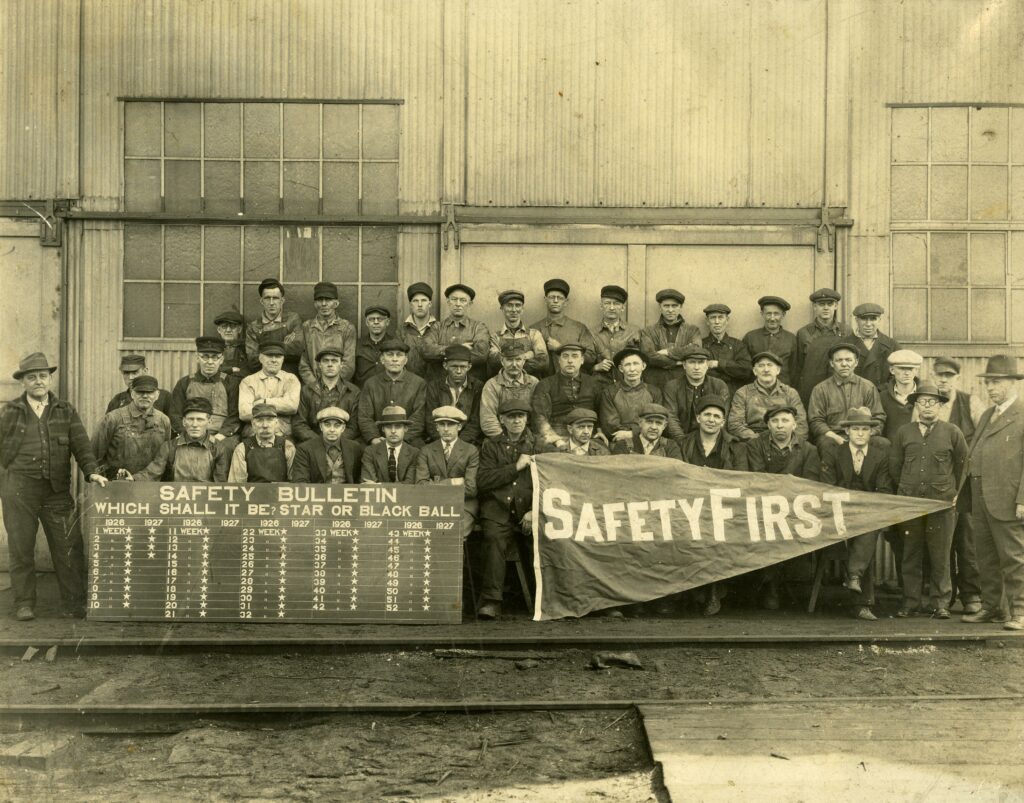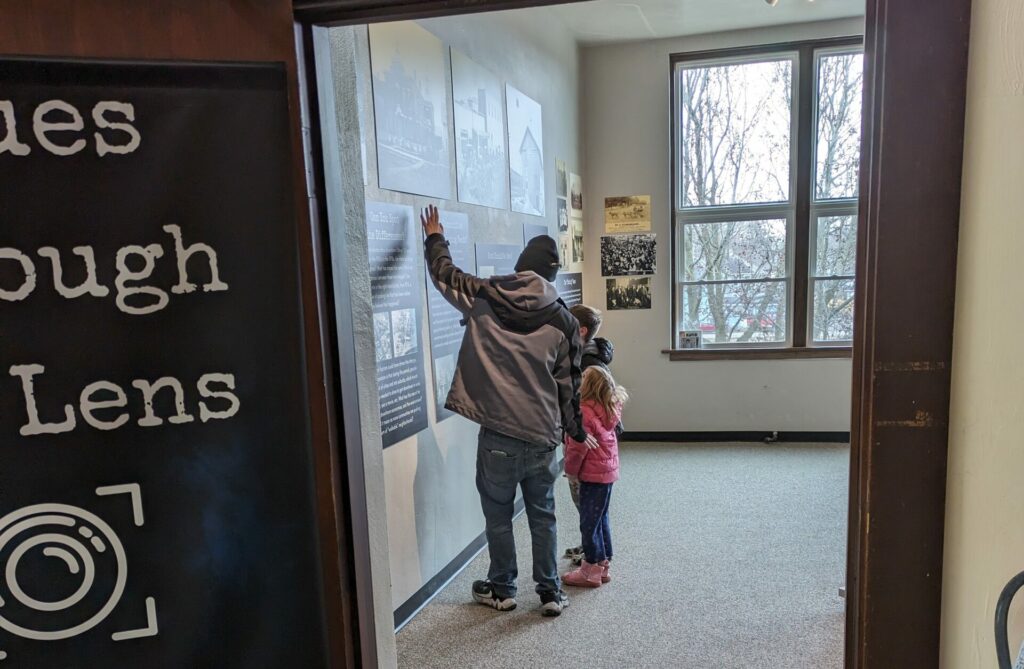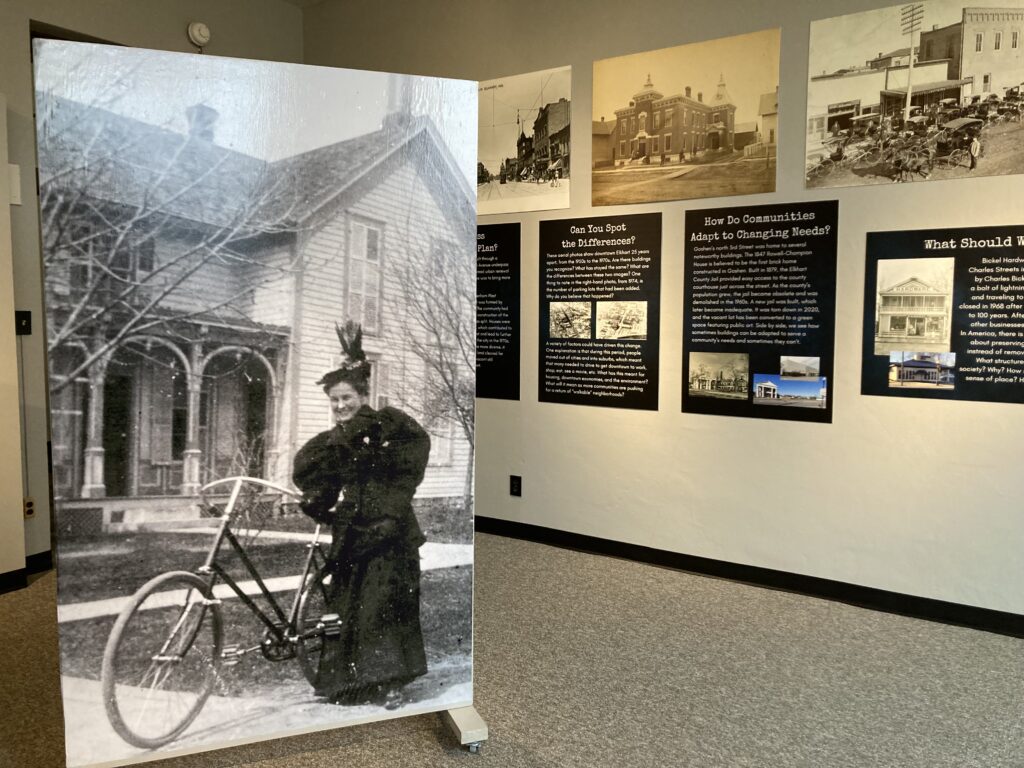In our latest article by Julie Parke, Museum Administrator at Elkhart County Historical Museum, find out how the museum drew inspiration from the AASLH Reframing History report to develop an innovative new exhibit that engages visitors in historical research.

New York Central Railroad Employees with “Safety” banner, 1927
The first thing you notice about the lead image for Clues Through the Lens is the safety banner. Take a longer look, however, and individual workers begin to stand out. You notice their clothing, their expressions, perhaps their ages.
Further into the experience, you see the cheerful exhibit mascot, Leona, and her bike; you might chuckle at the frowning little faces of the Parkside School rhythm section, a staff favorite; or weigh the loss of the Bickel Hardware building. But why do these images matter, and how does Clues Through the Lens spark this and other questions?
A Chance to Try Something New
The Elkhart County Historical Society (ECHS) was founded in 1896, and today the Elkhart County Historical Museum (ECHM) operates as a partnership between the Elkhart County Parks and the ECHS. Since 1968, the Museum has been housed in the former Bristol School (built 1903), and for decades, exhibition design was artifact-dense, leaving little room for meaningful interpretation. Between 2017 and 2020 the ECHM completed the transformation of three main-floor spaces into the Crossroads of Elkhart County exhibit galleries. The upper floor, however, remained in critical need of overhaul. Picture vignettes, room settings and cases full of artifacts with minimal to no context.
When critical building repairs were scheduled for a second-floor gallery, staff jumped at the chance to retire an outdated transportation exhibit with little interpretive value and create a multi-use or Special Exhibits space. Clues Through the Lens is the inaugural exhibit in the newly renovated gallery.
The timing of this project aligned with the publication of the Reframing History report. We soon found ourselves considering ways to weave this innovative approach to history into our programs and exhibits. The Clues exhibit is just one product of that effort. By considering the four recommendations in the report, Making History Matter, the staff explored and developed an exhibit featuring the Museum’s image collection that focused on the following six goals:
- To model the methods of historical research and interpretation for the visitors.
- To compare the work of history to detective work.
- To analyze the Museum’s photo collection through a series of questions.
- To build critical thinking skills of visitors.
- To interpret a more inclusive history while highlighting the Museum’s photo collection.
- To inspire conversations between visitors.
What does it take to do good history? Historians investigate, evaluate, and question sources to create as complete an understanding of the past as possible. Clues Through the Lens encourages visitors to participate actively in this process. This is a ground-breaking approach to an exhibit for us. Rather than simply sharing the history of Elkhart County, we hope visitors will be their own history detectives. To prompt that, the interpretive text leads with questions. Themes explored in the exhibit include values, perceptions, and changing landscapes. The exhibit also outlines the history of photography and includes several interactive features.

Clues Through the Lens – Family in exhibit
How the Approach Helps Us Fulfill Our Mission
In staying true to the Museum’s mission, Clues Through the Lens tells the ongoing story of Elkhart County by incorporating and interpreting more than 60 historic and current photographs of the region, spanning the 1860s to 2024. More importantly, however, the exhibit builds lasting connections by inviting visitors to undertake the work of “doing history” for themselves.
Discover, Inspire and Transform are mission-related calls to action, and Clues hits all three:
Discover
Through strategic collections management and the work of dedicated volunteers, the ECHM has digitized its collection of more than 10,000 images. The entire collection is being made available through the online platform Indiana Memory. This access makes the Clues project possible, and now the collection and the stories it can reveal are more discoverable than ever.
Inspire
The Big Idea driving this exhibit is “Doing good history is an ongoing process of asking questions. Photo collections can be especially evocative, both answering and sparking questions about the past.” Clues Through the Lens challenges Museum visitors to ask questions, of the images, of their own biases and of society, building not only an understanding of what their community’s history is but also how they can participate in the discovery and sharing of it.
Transform
Clues Through the Lens marks the first major update to the 2nd floor galleries in over a decade. It’s a huge step forward in modernizing the style, look, and interpretation of the Museum that began in 2018 with the opening of Forging a Path, the first gallery of the Crossroads of Elkhart County initiative. Beyond the physical transformation to the Museum, we hope to transform visitors and cultivate lifelong curiosity.
This exhibit continues the Museum’s work to try to center previously underrepresented stories. Themes including cultural appropriation, gender stereotypes and women’s equality, the unfulfilled promise of urban renewal and animal rights all have a place in the exhibit. By challenging visitors to examine their biases, it also aims to build empathy, which is crucial to breaking down barriers to diversity and inclusion.
As noted above, a group of workers from the New York Central Railroad anchors Clues Through the Lens. Taken in 1927, the image is significant, not because of what is captured, but because of who is missing. Although census data and history tell us that the NYCRR recruited African Americans from the rural South, it appears that there are no people of color included in the shot. The “Why?” asked here sets the stage for other subjects that may make visitors uncomfortable.
Embracing an experimental and creative spirit, Clues Through the Lens hopes to engage visitors as detectives, not to teach a history lesson, but rather to cultivate public engagement with the idea of history. By structuring the exhibit around questions posed to the audience, relevancy is ever-present in the interpretation. Through each theme area, visitors are encouraged to consider their own views and how they relate to our thoughts about the past and about society today.

Clues Through the Lens – Gallery Shot
What We’ve Learned
Clues Through the Lens is designed for all audiences and is grounded in self-directed, inquiry-based learning. Whether coming with a passion for history or photography, looking to be challenged, or to simply have fun, there are elements to engage visitors. Drawing on available images from the collection, staff cast as wide a net as possible to represent all of Elkhart County, but themes also will be relevant to visitors from outside the area. Although Clues is a 2-year exhibit, the outcomes and success of the project will continue. Ongoing programming and current and future exhibits will utilize both the image collection and the question-based, detective approach to visitor engagement.
A critical challenge made evident by Clues is the scarcity of people of color found in the Museum’s image collection. Topics addressing race are prominent in the exhibit, but the associated images do not reflect community demographics. The staff is addressing this disparity through related programs and discussions with visitors. This notable gap could inspire community members to consider image donations to help round out the collection.
In retiring the transportation gallery, staff anticipated resistance from long-time patrons. Train culture is prevalent here, and the “Depot” spoke to a deep nostalgia. However, we were gratified to find that Museum regulars generally were excited for something new. Additionally, as we all know, when there is more to see and do in the Museum, visitors stay longer.
While we’ve already learned much from this project, there are more lessons ahead. The interpretive approach that grounds Clues Through the Lens and related feedback will guide us as we move into the exploration and development of two exhibits slated for the semiquincentennial in 2026. Armed with the tools to act as detectives, shaping their own learning, visitors should be ready for anything.
